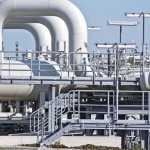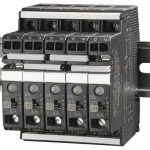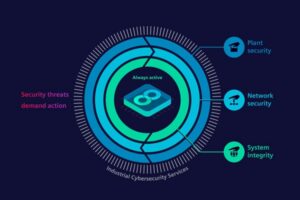Natural gas is one of the leading alternative energy choices for the fuel industry today and is considered the cleanest burning fossil fuel with minimal environmental impact. In order to ship it around the world, the gas has to be liquefied. There are several hazardous areas within the gas liquefaction plant. Electronic circuit breakers with Class I, Division 2, approval can protect against short-circuit and overload in these areas, and individually disconnect each field load if necessary.
An increase in the demand for energy worldwide has driven the search for alternative primary sources of energy, even in the most remote locations of the globe. The most popular way to move gas from source to end user is through pipelines, based on its relatively low energy content per unit of volume. However as transportation distances increase, so does the cost of the pipeline – making it difficult to transport natural gas from the wellhead to the customer economically. To optimise the transportation of natural gas, a liquefaction process is used. This process converts natural gas into liquefied natural gas (LNG) by refrigerating the former to -162 °C, resulting in a reduction in volume to approximately 1/600 of its gaseous form.
The chemical make-up of natural gas includes complex contaminates such as CO2, H2S, CO and other acidic gases, which can hinder the liquefaction process. For example, CO2 can freeze on exchanger surfaces, plugging lines and reducing plant efficiency. There is therefore a need to extract the CO2 before the liquefaction process begins. This is needed not only to overcome process bottlenecks but also to meet LNG product specifications and prevent corrosion of process equipment and the plant environment.
There are many gas treating processes available for removing CO2 from natural gas. They include chemical solvents, physical solvents, adsorption processes, hybrid solvents and physical separation. Chemical and physical solvents, or combinations of the two, have been used extensively in existing LNG facilities. There is one factor common to all of these gas treating processes: they all require a sophisticated process control system. Most of these systems are configured with a high-level, redundant DCS or PLC controller, utilising industrial networks to connect the hundreds of inputs and outputs, both analogue and digital based, for the instrumentation and valves that control and monitor the entire process. These applications are also considered to be in hazardous locations for electrical control equipment and instrumentation, mainly because of the possibility of explosion during liquefaction and regasification processes as well as the electrical arcing components incorporated into the control cabinet. This environment is known as a Class I, Division 2, hazardous location.
Several options are available to deploy an automation control system in a hazardous environment. In the past, NEMA 7 explosion-proof enclosures were predominately used to install the electrical controls. These enclosures are designed to prevent any arc-ing or flame from a faulty component inside the enclosure to the volatile process area outside. Today, a NEMA 4/4X industrial enclosure is commonly utilised with an air purge system. This system exchanges the air inside the enclosure with fresh air processed by the purge system – minimising high concentration levels of hazardous gases in the enclosure that could cause an explosion with arcing components, such as electrical relays, switches, fuses, circuit breakers, etc. As a substitute for both of these options, E-T-A offers a line of solid-state electronic circuit breakers for applications in Class I, Division 2, hazardous locations. This solid-state technology is an alternative for protecting 24 VDC field devices in hazardous environments because as long as all the components installed in an electrical control enclosure have a Class I, Division 2, approval, the NEMA 7 enclo-sure and/or purge system are no longer needed to meet most application specifications.
Individual disconnection
E-T-A, along with a leading LNG system supplier, successfully deployed its solid-state electronic product on an LNG pre-treatment application. Several factors led the electrical control engineering team to implement this technology into its design, including the need to meet specifications by providing all field devices with overload and short-circuit protection as well as a means for individual disconnection of each field load in a Class I, Division 2, hazardous location. By integrating E-T-A’s solid-state device, the LNG system supplier benefitted from better protection for field devices than with any other technology available for 24 VDC switched-mode power supplies. The product is designed to detect both an overload and short-circuit condition within 200 ms of the overcurrent event. Since this component has a current limiting function, it supplies no more than 1.3 times the rated current of the circuit breaker at any time during the fault condition, then after 3 s completely disconnects the current from the switched-mode power supply to the load. In the event of an overload or short-circuit, the device permits individual disconnection between the power source and the load via a power switch on the front of the product. Other models have a remote reset option that allows a PLC/DCS control output to disable or disconnect the current flow to the field load, thus preventing the power supply from being compromised by a single point of failure.
Fast fault recognition
The ESX10-T circuit breaker carries a UL 1604, Class I, Division 2 (CID2), approval that allows it to be used in this application with a CID2 switched-mode power supply, I/O modules, terminal blocks and industrial switches. As all of the components are CID2 approved, a purge system was not required for this project. The system was deployed in a standard NEMA 4X double-door enclosure. This saved significant time and cost throughout the entire project cycle, from the design phase through the electrical checkout and customer acceptance testing to the final site installation. In the long term, the end user will no longer have to maintain a purge system and the associated output alarms to the process control system.
The basic device is designed with a red/green LED mounted on the face that provides an immediate visual indication of the circuit breakers output states to simplify troubleshooting hundreds of I/O field devices. More advanced models have an active high or low output signal that can be used to integrate with the PLC/DCS control system or enclosure door-mounted pilot light. This feature increases production for the end user by locating the root cause of a field device failure very quickly, and allows the company to get back on line making product once again. As an additional benefit, the status indication on the device reduces the amount of time neces-sary to identify faulty instruments in the control system during the initial electrical start-up. The integration of this alternative approach enabled the system supplier to meet its project goals by fulfilling the required Class I, Division 2, load protection specification as well as individual disconnection of all the field instruments and valve devices.
Online-Info www.cpp-net.com/2210444
Share:








